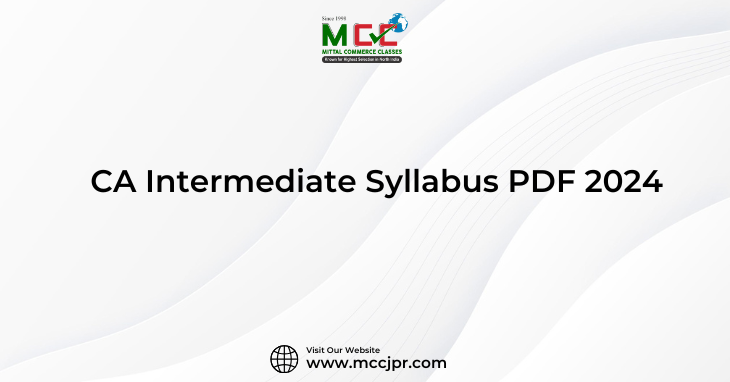If you are searching for CA Intermediate Syllabus Course Material, then you are on the right page. MCC brings you full study materials and also a complete CA inter course syllabus for May 2024 exam pattern.
Furthermore, Mittal Commerce classes provide both online and offline coaching to those who want to do CA, CMA, 11th, or 12th commerce coaching. And also, If you want to take online coaching, you can visit our page at https://mccjpr.com/buy-online-course/.
The New ICAI Course Study Material for May 2024 onwards is available for CA Inter. CA Aspirants can download the New Study Material of ICAI for May 2024 from this page.
About CA Inter Examination
The CA Intermediate Syllabus consists of 6 papers divided into 2 groups. In Group 1, there are 3 papers, i.e., Advance Accounting (Paper 1), Corporate Law (Paper 2), and Taxation (Paper 3). In Group 2, again, there are 3 papers, i.e., Cost and Management Accounting (Paper 4), Auditing and Code of Ethics (Paper 5), and Financial Management and Strategic Management (Paper 6). Whereas, Each paper is worth 100 marks, resulting in overall 600 marks for the entire exam. And this Exam will be conducted by ICAI.
Also Read: Best CA Inter Coaching In India
Let’s Discuss Each Paper In Detail:
Paper 1: Advance Accounting
Advanced Accounting refers to the study and application of more complex accounting principles. And also practices beyond the fundamentals covered in introductory accounting courses. This accounting field deals with sophisticated financial reporting, analysis, and decision-making.
Advanced Accounting is divided into 3 modules, i.e., module 1 contains 4 chapters, module 2 contains 6 chapters, and module 3 contains 5 chapters.
| MODULE 1 | MODULE 2 | MODULE 3 |
|---|---|---|
| Chapter 1: Introduction to Accounting Standards | Chapter 5: Assets Based Accounting Standards | Chapter 11: Financial Statements of Companies |
| Chapter 2: Framework for Preparation and Presentation of Financial Statements | Chapter 6: Liabilities Based Accounting Standards | Chapter 12: Buyback of Securities |
| Chapter 3: Applicability of Accounting Standards | Chapter 7: Accounting Standards Based on Items Impacting Financial Statement | Chapter 13: Amalgamation of Companies |
| Chapter 4: Presentation & Disclosures Based Accounting Standards | Chapter 8: Revenue Based Accounting Standards | Chapter 14: Accounting for Reconstruction of Companies |
| Chapter 9: Other Accounting Standards | Chapter 15: Accounting for Branches including Foreign Branches | |
| Chapter 10: Accounting Standards for Consolidated Financial Statement |
Paper 2: Corporate and Other Laws
Corporate law is a branch of legal study and practice that focuses on the legal framework and rules governing corporations. This field covers a wide range of legal issues relating to the formation, operation, and dissolution of corporations.
Corporate and Other Laws is divided into two parts. Part 1 and Part 2. Here, Part 1 is named Company Law and Limited Liability Partnership Law and is divided into 3 modules: Module 1 contains 6 chapters, Module 2 contains 5 chapters, and Module 3 contains 1 chapter. Part 2 is named Other Laws and is divided into 3 chapters.
PART I – COMPANY LAW AND LIMITED LIABILITY PARTNERSHIP LAW
| MODULE 1 | MODULE 2 | MODULE 3 |
| Chapter 1: Preliminary | Chapter 7: Management & Administration | Chapter 12: The Limited Liability Partnership Act, 2008 |
| Chapter 2: Incorporation of Company and Matters Incidental Thereto | Chapter 8: Declaration and Payment of Dividend | |
| Chapter 3: Prospectus and Allotment of Securities | Chapter 9: Accounts of Companies | |
| Chapter 4: Share Capital and Debentures | Chapter 10: Audit and Auditors | |
| Chapter 5: Acceptance of Deposits by Companies | Chapter 11: Companies Incorporated Outside India | |
| Chapter 6: Registration of Charges |
PART II – OTHER LAWS
1st Chapter: The General Clauses Act, 1897
2nd Chapter: Interpretation of Statutes
3rd Chapter: The Foreign Exchange Management Act, 1999
Paper 3: Taxation
Taxation is the process by which governments collect revenue from individuals and businesses to fund public expenditures and services. Moreover, it is a complex field involving various types of taxes, regulations, and compliance requirements.
Taxation is divided into two sections,i.e., Section 1 and Section 2. Whereas, Section 1 is named Income-tax Law, and Section 2 is named Goods and Services Tax.
Section A: Income-tax Law
| MODULE 1 | MODULE 2 |
| SECTION I
Overview, Scenario, Crossword Puzzle Chapter 1: Basic Concepts Chapter 2: Residence and Scope of Total Income |
SECTION III
Overview, Scenario, Crossword Puzzle Chapter 4: Income of Other Persons included in Assessee’s Total Income Chaptr 5: Aggregation of Income, Set-Off and Carry Forward of Losses Chapter 6: Deductions from Gross Total Income |
| SECTION II
Overview, Scenario, Crossword Puzzle Chapter 3: Heads of Income
|
SECTION IV
Overview, Scenario, Crossword Puzzle
Chapter 7: Advance Tax, Tax Deduction at Source and Tax Collection at Source Chapter 8: Provisions for filing Return of Income and Self Assessment |
| SECTION V
Overview, Scenario Chapter 9: Income Tax Liability – Computation and Optimisation |
Section B: Goods and Services Tax
| MODULE 1 | MODULE 2 |
| Chapter 1: GST in India – An Introduction | Chapter 8: Input Tax Credit |
| Chapter 2: Supply under GST | Chapter 9: Registration |
| Chapter 3: Charge of GST | Chapter 10: Tax Invoice; Credit and Debit Notes |
| Chapter 4: Place of Supply | Chapter 11: Accounts and Records |
| Chapter 5: Exemptions from GST | Chapter 12: E-Way Bill |
| Chapter 6: Time of Supply | Chapter 13: Payment of Tax |
| Chapter 7: Value of Supply | Chapter 14: Tax Deduction at Source and Collection of Tax at Source |
| Chapter 15: Returns |
Paper 4: Cost and Management Accounting
Cost and Management Accounting is a specialized branch of accounting that focuses on providing information to internal management and also for decision making, planning, control, and performance evaluation. It also involves in the analysis and interpretation of financial information related to the costs of producing goods and services.
Cost and Management Accounting is divided into two modules, i.e., Module 1 and Module 2. Furthermore, Module 1 contains 7 chapters, Module 2 contains 8 chapters.
| MODULE 1 | MODULE 2 |
| Chapter 1: Introduction to Cost and Management Accounting | Chapter 8: Unit & Batch Costing |
| Chapter 2: Material Cost | Chapter 9: Job Costing |
| Chapter 3: Employee Cost and Direct Expenses | Chapter 10: Process & Operation Costing |
| Chapter 4: Overheads – Absorption Costing Method | Chapter 11: Joint Products and By Products |
| Chapter 5: Activity Based Costing | Chapter 12: Service Costing |
| Chapter 6: Cost Sheet | Chapter 13: Standard Costing |
| Chapter 7: Cost Accounting Systems | Chapter 14: Marginal Costing |
| Chapter 15: Budgets and Budgetary Control |
Paper 5: Auditing and Ethics
Auditing and Ethics are equally important parts of the accounting profession, ensuring the reliability of financial information and maintaining ethical standards
Are linked in the accounting profession, with auditors providing independent assurance of financial information while upholding ethical principles to maintain public trust and confidence in the integrity of financial reporting.
Auditing and Ethics is also divided into two modules, i.e., Module 1 and Module 2. Whereas, Module 1 contains 5 chapters, Module 2 contains 6 chapters.
| MODULE 1 | MODULE 2 |
| Chapter 1: Nature, Objective and Scope of Audit | Chapter 6: Audit Documentation |
| Chapter 2: Audit Strategy, Audit Planning and Audit Programme | Chapter 7: Completion and Review |
| Chapter 3: Risk Assessment and Internal Control | Chapter 8: Audit Report |
| Chapter 4: Audit Evidence | Chapter 9: Special Features of Audit of Different Type of Entities |
| Chapter 5: Audit of Items of Financial Statements | Chapter 10: Audit of Banks |
| Chapter 11: Ethics and Terms of Audit Engagements |
Must visit: ICAI CA Inter Auditing Study Material
Paper 6: Financial Management and Strategic Management
Section A: Financial Management
Financial Management involves planning, organizing, directing, and also controlling the financial resources of an organization to achieve its objectives. Also It focuses on improving the allocation and utilization of funds.
Financial Management is divided into two modules ,i.e. Module 1 and Module 2. Module 1 further divided into 6 chapters, Module 2 contains 3 chapters.
| MODULE 1 | MODULE 2 |
| Chapter 1: Scope and Objectives of Financial Management | Chapter 7: Investment Decisions |
| Chapter 2: Types of Financing | Chapter 8: Dividend Decision |
| Chapter 3: Financial Analysis and Planning – Ratio Analysis | Chapter 9: Management of Working Capital
|
| Chapter 4: Cost of Capital | |
| Chapter 5: Financing Decisions – Capital Structure | |
| Chapter 6: Financing Decisions – Leverages |
Section B: Strategic Management
Strategic Management involves the formulation and implementation of strategies to achieve long-term goals and objectives. Moreover, It encompasses planning, monitoring, and adjusting the direction of the organization in response to internal and external factors.
| MODULE 1 |
| Chapter 1: Introduction to Strategic Management |
| Chapter 2: Strategic Analysis: External Environment |
| Chapter 3: Strategic Analysis: Internal Environment |
| Chapter 4: Strategic Choices |
| Chapter 5: Strategy Implementation and Evaluation |
Must Read: India’s Top CA Intermediate Online Coaching Classes
Frequently Asked Questions
Q1: How many papers are there in CA Intermediate Syllabus 2023 exams?
There are a total of 8 papers included in CA Intermediate Syllabus exam. These papers are equally divided into two groups.
Q2: Which is the toughest subject of CA Inter?
Auditing is recognized as the most difficult subject in CA Intermediate Syllabus. Because this subject is the most competitive as a person cannot study this subject on his own.
Q3: Is CA easier than MBA?
Becoming a CA is probably more difficult than getting an MBA.














